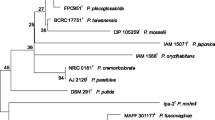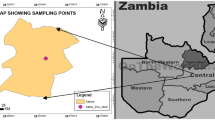Abstract
A novel indigenous Pseudomonas aeruginosa strain (MTCC 4996) isolated from a pulp industrial effluent-contaminated site was capable of degrading phenol up to a concentration of 1,300 mg L−1 within 156 h. Complete degradation was observed at pH values ranging from 6.0 to 10.0 and temperatures from 15 to 45°C, with an optimum pH of 7.0 and optimum temperature of 37°C. At an optimum shaking speed of 100–125 rpm, 100% degradation was observed in 66 h, as compared to 84 h under static conditions. Glucose and peptone at lower concentrations enhanced phenol degradation. The rate of phenol degradation was most sensitive to added Hg. Low concentrations of Fe, Cu, Pb, Zn, and Mn stimulated and enhanced the rate of degradation.






Similar content being viewed by others
References
Aksu S, Yener J (1998) Investigation of biosorption of phenol and monochlorianated phenols on the dried activated sludge. Process Biochem 33:649–655
Allsop PJ, Chisti Y, Moo-Young M, Sullivan GR (1993) Dynamics of phenol degradation by Pseudomomas putida. Biotechnol Bioeng 41:572–580
Annadurai G, Mathalai Balan S, Murugesan T (1999) Box-Behnken design in the development of optimized complex medium for phenol degradation using Pseudomonas putida (NICM 2174). Bioprocess Eng 21:415–421
Annadurai G, Juang RS, Lee DJ (2002) Microbiological degradation of phenol using mixed liquors of Pseudomonas putida and activated sludge. Waste Manage 22:703–710
Armenante PM, Fava F, Kafkewitz D (1995) Effect of yeast extract on growth kinetics during aerobic biodegradation of chlorobenzoic acid. Biotechnol Bioeng 47:227–233
Barkay T (1987) Adaptation of aquatic microbial communities to Hg2+ stress. Appl Environ Microbiol 53:2725–2732
Bulbul G, Aksu Z (1997) Investigation of wastewater treatment containing phenol using free and Ca-alginated gel immobilized Pseudomonas putida in a batch stirred reactor. Turkish J Eng Environ Sci 21 175–181
Caturla F, Martin-Martinez JM, Molina-Sabio M, Rodriguez-Reinoso F, Torregrosa R (1998) Adsorption of substituted phenols on activated carbon. J Coll Interface Sci 124:528–534
Chitra S (1995) Studies on biodegradation of phenolic compounds by Pseudomonas pictorum. PhD thesis CLRI, University of Madras, Chennai-25
Chung TS, Loh K-C, Tay HL (1998) Development of polysulfone membranes for bacteria immobilization to remove phenol. J Appl Polym Sci 70:2585–2594
Chung TP, Tseng HY, Juang RS (2003) Mass transfer effect and intermediate detection for phenol degradation in immobilized Pseudomonas putida systems. Process Biochem 38:1497–1507
Chun-Wei K, Barbara RSG (1996) Effect of added heavy metal ions on biotransformation and biodegradation of 2-chlorophenol and 3-chlorobenzoate in anaerobic bacterial consortia. Appl Environ Microbiol 62:2317–2323
Folsom BR, Chapman PJ, Pritchard PH (1990) Phenol and trichloroethylene degradation by Pseudomonas cepacia G4: kinetics and interactions between substrates. Appl Environ Microbiol 56:1279–1285
Gupta VK, Sharma S, Yadav IS, Mohan D (1998) Utilization of bagasse fly ash generated in the sugar industry for the removal and recovery of phenol and P-nitrophenol from wastewater. J Chem Technol Biotechnol 71:180–186
Hill GA, Robinson CW (1975) Substrate inhibition kinetics: phenol degradation by Pseudomonos Putida. Biotechnol Bioeng 17:1599–1615
Hughes MN, Poole RK (1989) Metal toxicity. In: Hughes MN, Poole RK (eds) Metals and microorganisms. Chapman and Hall, New York, pp 252–302
Kim JW, Armstrong ME (1981) A comprehensive study on the biological treatabilities of phenol and methanol II. The effects of temperature, pH salinity and nutrients. Water Res 15:1233–1247
Kobayashi W, Rittmann BE (1982) Microbial removal of hazardous organic compounds. Environ Sci Technol 16:170–183
Kotresha D (2005) Phenol: Biotechnological approaches in microbial degradation and stress responses in crop plants. PhD thesis, Gulbarga University, Gulbarga, India
Liesegang H, Lemke K, Siddiqui RA, Schlegel HG (1993) Characterization of the inducible nickel and cobalt resistance determinant cnr from pMOL28 of Alcaligenes eutrophus CH34. J Bacteriol 175:767–778
Lob KC, Tar PP 2000 Effect of additional carbon sources on biodegradation of phenol. Bull Environ Contam Toxicol 64:756–763
Loh KC, Wang SJ (1998) Enhancement of biodegradation of phenol and a nongrowth substrate 4-chlorophenol by medium augmentation with conventional carbon sources. Biodegradation 8:329–338
Loh KC, Chung TS, Wei-Fern A (2000) Immobilized cell membrane bioreactor for high strength phenol wastewater. J Environ Eng 126:75–79
Margesin R, Schinner F (1997) Effect of temperature on oil degradation by a psychrotrophic yeast in liquid culture and in soil. FEMS Microbiol Ecol 24:243–249
Masque C, Nolla M, Bordons A (1987) Selection and adaptation of a phenol degrading strain of Pseudomonas. Biotechnol Lett 9:655–660
Mergeary M, Nies D, Schlegel HG, Gerits J, Charles P, van Gi-jsegem F (1985) Alcaligenes eutrophus CH34 is a facultative chemohthotroph with plasmid-bound resistance to heavy metals. J Bacteriol 162:123–135
Nies DH (1999) Microbial heavy-metal resistance. Appl Microbiol Biotechnol 51:730–750
Pakula A, Bieszkiewicz E, Boszczyk Maleszak H, Mycielski R (1999) Biodegradation of phenol by bacterial strains from petroleum-refining wastewater purification plant. Acta Microbiol Pol 48:373–380
Papanastasious AC (1982) Kinetics of biodegradation of 2,4-Dichlorophenoxyacetate in the presence of glucose. Biotechnol Bioeng 24:2001–2011
Paraskevi NP, Euripides GS (2005) Effect of temperature and additional carbon sources on phenol degradation by an indigenous soil Pseudomonad. Biodegradation 16:403–413
Rengaraj S, Seung-hyeon Moon, Sivabalan R, Arabindoo B, Murugesan V (2002) Agricultural solid waste for the removal of organics: adsorption of phenol from water and wastewater by palm seed coat activated carbon. Waste Manage 22:543–548
Robertson BK, Alexander M (1992) Influence of calcium, iron and pH on phosphate availability for microbial mineralization of organic chemicals. Appl Environ Microbiol 58:38–41
Saha NC, Bhunia F, Kaviraj A (1999) Toxicity of phenol to fish and aquatic ecosystems. Bull Environ Contam Toxicol 63:195–971
Satsangee R, Ghosh P (1990) Anaerobic degradation of phenol using an acclimated mixed culture. Appl Microbiol Biotechnol 34:127–130
Schmidt T, Schlegel HG (1994) Combined nickel–cobalt–cadmium resistance encoded by the ncc locus of Alcaligenes Xylosoxidans 31A. J Bacteriol 176:7045–7054
Singleton I (1994) Microbial metabolism of xenobiotics: fundamental and applied research. J Chem Technol Biotechnol 59:9–23
Soda S, Ike M, Fujita M (1998) Effects of inoculation of a genetically engineered bacterium on performance and indigenous bacteria of a sequencing batch activated sludge process treating phenol. J Ferment Bioeng 86:90–96
Sterritt RM, Lester JN (1980) Interactions of heavy metals with bacteria. Sci Total Environ 14:5–17
Sung RH, Soydoa V, Hiroaki O (2000) Biodegradation by mixed microorganism of granular activated carbon loaded with a mixture of phenols. Biotechnology Lett 22:1093–1096
Topp E, Hanson RS (1990) Degradation of pentachlorophenol by a Flavobacterium species grown in continuous culture under various nutrient limitations. Appl Environ Microbiol 56:541–544
Topp E, Crawford RL, Hanson RS (1988) Influence of readily metabolisable carbon on pentachlorophenol-degrading Flavobacterium sp. Appl Environ Microbiol 54:2452–2459
Trevors J, Oddie K, Belliveau B (1985) Metal resistance in bacteria. FEMS Microbiol Rev 32:39–54
Wallace J (1991) Phenol. In: Kroschwitz JI (ed) Kirk-Othmer Encyclopedia of Chemical Technology. Wiley, New York, pp 592–602
Wang SJ, Loh KC (1999) Modelling the role of metabolic intermediates in kinetics of phenol biodegradation. Enzyme Microb Technol 25:177–184
Yoo J-Y, Choi J, Leer T, Park J-W (2004) Organobentonite for sorption and degradation of phenol in the presence of heavy metals. Water Air Soil Pollut 154:225–237
Author information
Authors and Affiliations
Corresponding author
Rights and permissions
About this article
Cite this article
Kotresha, D., Vidyasagar, G.M. Isolation and characterisation of phenol-degrading Pseudomonas aeruginosa MTCC 4996. World J Microbiol Biotechnol 24, 541–547 (2008). https://doi.org/10.1007/s11274-007-9508-2
Received:
Accepted:
Published:
Issue Date:
DOI: https://doi.org/10.1007/s11274-007-9508-2




